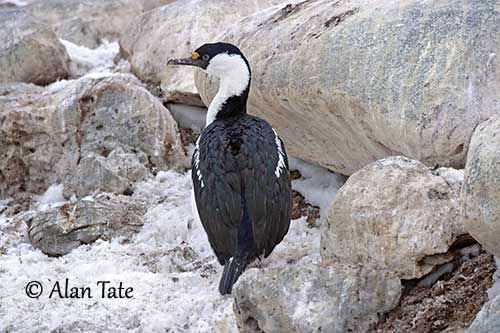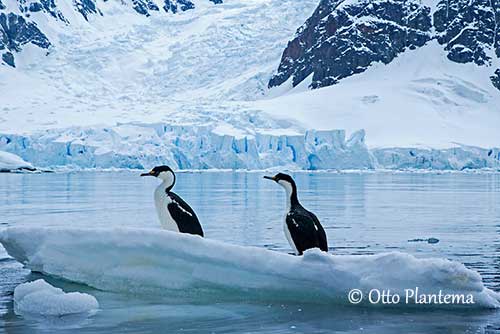
Fr: Cormoran antarctique
Ang: Antarctic Shag
All: Antarktikscharbe
Esp: Cormorán Antártico
Ita: Cormorano antartico
Nd: Antarctische Aalscholver
Sd: antarktisskarv
Photographers:
Otto Plantema
Trips around the world
Alan & Ann Tate
AA Bird Photography
Text by Nicole Bouglouan
Sources :
HANDBOOK OF THE BIRDS OF THE WORLD vol 1 by Josep del Hoyo-Andrew Elliot-Jordi Sargatal - Lynx Edicions - ISBN: 8487334105
A Complete Guide to Antarctic Wildlife by Hadoram Shirihai and Illustrated by Brett Jarrett - Edited by Guy M. Kirwan - ALUL.A Press Oy, Finland - ISBN 9519894705
Antarctica: A Guide to the Wildlife Par Tony Soper
Sexual Size Dimorphism in the Antarctic Shag
Fish in the diet of the Antarctic shag at Laurie Island, South Orkney Islands
Diet of post-breeding Antarctic Shags at Cockburn island, Antarctic Peninsula
Why is wing-spreading behaviour absent in blue-eyed shags?
Antarctic Shag
Leucocarbo bransfieldensis
Suliformes Order – Phalacrocoracidae Family
INTRODUCTION:
The Antarctic Shag belongs to the “blue-eyed” complex and is placed in the genus Leucocarbo. It is now lumped within Imperial Shag, but it is still often considered a full species.
The shags Leucocarbo are characterized by more pelagic tendencies and stronger flight. The Antarctic Shag is known to reach at least depths of 25 metres when diving for food.
This species is found on the Antarctic Peninsula and the South Shetland Islands where it breeds in colonies during the Austral summer.
The Antarctic Shag is not globally threatened. It is abundant within its range, with stable or increasing population after some decline in the 1980/1990s.

DESCRIPTION OF THE BIRD:
Biometrics:
Length: 75-77 cm
Wingspan: 124 cm
Weight: 2500-3000 g
The Antarctic Shag has black upperparts with bluish to greenish-blue gloss, including head, wings and outer parts of the thighs. Some outer scapulars may be white.
There is a narrow, white wingbar on the upperwing, formed by several lesser wing-coverts. This wingbar may vary in size. The back often shows a large, central, white patch. The tail is blackish and duller than the upperparts, with whitish shafts at base.
The underparts are white but the underwing is blackish with blacker lesser and medium coverts. The leading edge shows variable amount of white at base.
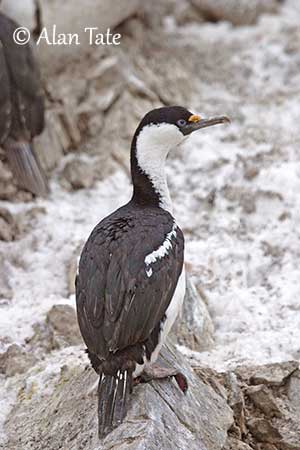
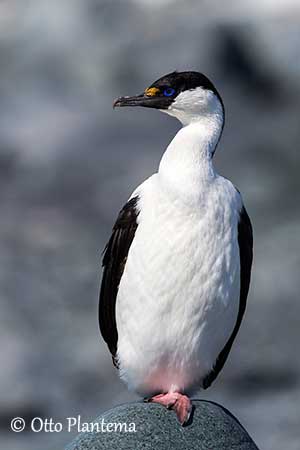
On the head, we can see a black crest on the crown. There are some white filoplumes on head and upperparts, related to the breeding season. But as this period is progressing, the crest is much reduced, the filoplumes are lost and the plumage becomes duller.
The prominent warty caruncles on each side of the forehead are bright yellow. The bare skin from lores to gape and on gular pouch is blackish. The eyering is blue, becoming duller bluish after the reproduction.
The bill is blackish with variable brownish-yellow tinge, and the lower mandible has paler tip. The eyes are dark brown. Legs and webbed feet are pink with black claws.
Male and female have similar plumage, but the female is smaller than male, with smaller bill.
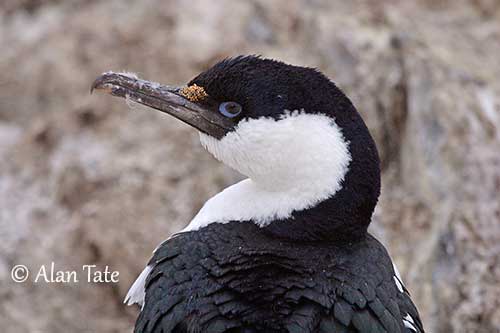
The juvenile is mostly dark brown and duller than adults. The white dorsal patch is absent. The wing-coverts are tipped paler brownish. The eyering is dull and the caruncles are lacking.
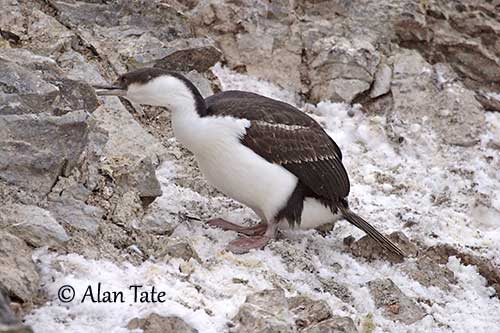
RANGE:
The Antarctic Shag breeds on the Antarctic Peninsula, on the South Shetland Islands and on Elephant Island.
HABITAT:
The Antarctic Shag breeds on low sea cliffs, rocky slopes and outcrops, and even on flat ground on coasts and islets. It usually remains close inshore to coast and islands and to pack ice.
CALLS AND SONGS: SOUNDS BY XENO-CANTO
The Antarctic Shag male usually gives “honk” calls while the female hisses. The male produces “aaaark” calls during threat behaviour, and is more vocal during the courtship displays.
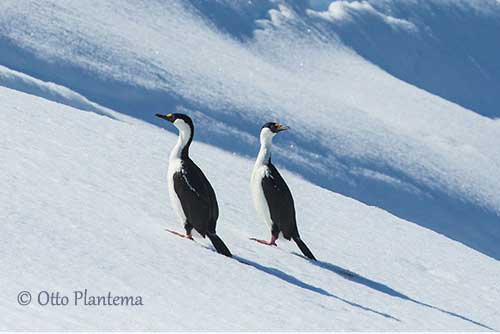
BEHAVIOUR IN THE WILD:
The Antarctic Shag forages alone or in small groups. They often swim and dive synchronously. The diet includes primarily fish, but it also takes crustaceans, squid and benthic invertebrates. The prey are caught by pursuit-diving underwater.
After the breeding season, they move farther out to sea in large flocks.
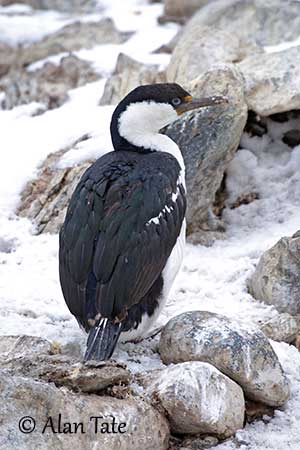
The Antarctic Shag is monogamous. The pair often returns to the same nest-site, but mates may change each year. Both adults share all the nesting duties. They nest in colonies from some tens to several hundreds, sometimes alongside Spheniscidae colonies.
The displays are probably typical of the Phalacrocoracidae, with “wing-weaving”, bill pointed upwards and forwards to display the bright colours of both caruncles and eyering, and “gargling” with the head touching the rump.
The male performs “greeting displays” when a female lands close to it and is accepted.
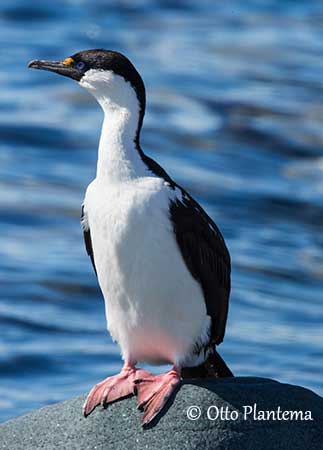
The Antarctic Shag is sedentary and usually remains in the vicinity of the colonies. It may move short distances in winter to find ice-free water for foraging.
They return to roost before sunset. Thanks to the very dense inner plumage, they do not need to perform “wing-spreading” to dry after diving in such cold temperatures.
The flight is powerful with regular, continuous wingbeats interspersed with occasional glides.
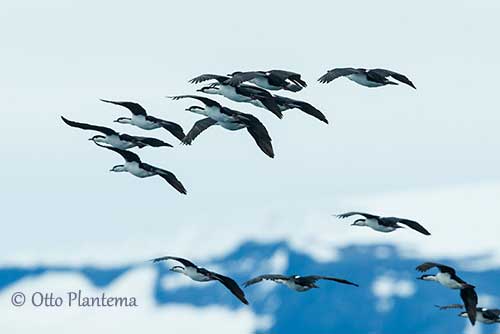
REPRODUCTION OF THIS SPECIES:
The laying occurs between October and December or mid-January. The Antarctic Shag nests in colonies from 20-40 pairs up to 800 pairs. They are established in rocky areas on cliffs, outcrops and islets.
The nest is a truncated cone made with seaweeds, feathers and various debris found in the surrounding. The nest materials are cemented with excreta. Both adults build the nest.
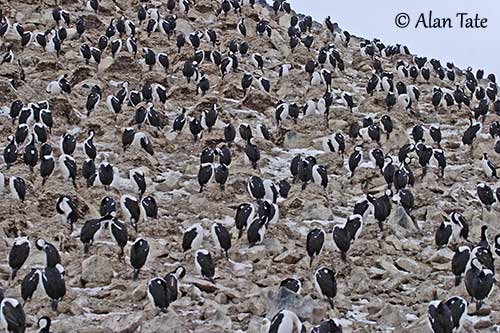
The female lays 2-3 eggs and both adults incubate during 28-31 days, but the male does most of incubation. At hatching, the chicks are naked, but some blackish-brown down grows very soon. They are fed at nest and brooded by their parents during three weeks. They fledge 40-45 days after hatching, and tend to gather in sociable flocks close to the waterline.
They are preyed upon by skuas, sheathbills and leopard seals.
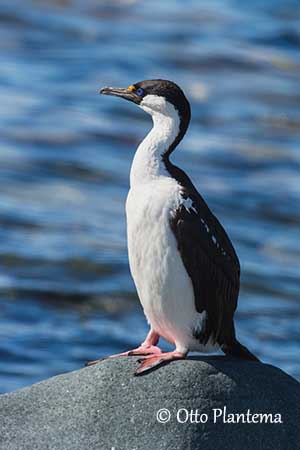
PROTECTION / THREATS / STATUS:
The Antarctic Shag is abundant with 10,000 pairs over 56 colonies on the Antarctic Peninsula, 700 pairs at 21 colonies in South Shetland Islands, and more than 200 pairs at 14 colonies on Elephant Island. The breeding success depends largely on food availability.
The overall population is now stable or even increasing (2001/2007). The breeding colonies are vulnerable to tourist activities, but currently, the Antarctic Shag is not globally threatened.
